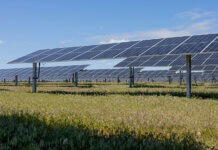The Solar Energy Generating Systems (SEGS) facility in California’s Mojave Desert recently retired five of its solar plants (SEGS 3 through 7) and plans to retire a sixth (SEGS 8) this month, based on information submitted to U.S. Energy Information Administration (EIA) and published in its Preliminary Electric Generator Inventory.
After SEGS 8 is retired, only one solar thermal unit at SEGS will remain operating (SEGS 9).
SEGS, which began operating in 1984, is the world’s longest-operating solar thermal power facility.
Solar thermal power plants use mirrors to focus sunlight onto a receiver, which absorbs and converts the sunlight into thermal energy (heat). The heat is used to drive a turbine, which produces electricity. The SEGS units are parabolic trough concentrating solar thermal power (CSP) systems, meaning that parabolic (u-shaped) mirrors capture and concentrate sunlight to heat synthetic oil in a central tube, which then boils water to create steam. The steam drives the turbine, generating electricity.
The 356 MW SEGS facility was originally made up of nine solar thermal plants. SEGS 1 and 2 were retired in 2015 and replaced with two solar photovoltaic (PV) farms, Sunray 2 and Sunray 3. SEGS 3 through 7 (each with 36 MW of capacity) came online from 1986 to 1988. SEGS 8 and 9 (each with 88 MW of capacity) came online in 1989 and 1990, respectively.
Solar thermal plants account for a relatively small share of utility-scale U.S. solar electric generating capacity. As of June 2021, the U.S. had about 52,600 MW of utility-scale solar capacity. Of that total, 3.3% was solar thermal; the remaining 96.7% was utility-scale solar PV.





Why are they being retired?